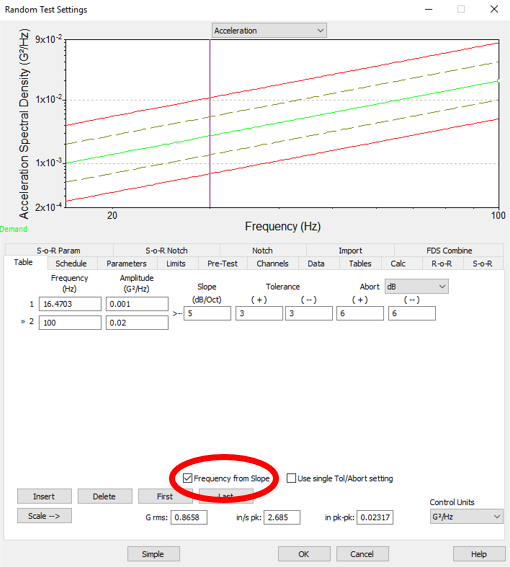VibrationVIEW 2019 is ready and waiting for you to download. Packed with new features, fully tested, and 100% compatible with all shakers makes it an easy upgrade for your testing operations.
Enhanced Testing
Real-time FFT display in Random
The random package now allows users to display an ongoing FFT calculation during a live test or playback of a time history file. Because the FFT graph doesn’t involve the averaging used for a PSD graph, an isolated spike in a frequency response is instantly visible. Previously, this feature was only available with the Analysis package.
Option to define breakpoints by a fixed slope entry
Adding even more flexibility to the breakpoint table definition, VibrationVIEW will now calculate breakpoint frequencies, given the desired amplitude and slope between breakpoints.
New capabilities for mixed-modes (SoS/SoR)
To help deal with unique phenomena and complex situations, users can now define high and low abort limits for each individual sine tone during Sine-on-Sine (SoS) and Sine-on-Random (SoR) mixed-mode tests.
Along the same lines, all notching options currently available with Sine and Random tests are now also available with SoS and SoR mixed-mode tests.
Required velocity for a test displayed in Peak
The required velocity for a Random test profile is now displayed in Peak rather than RMS. This is convenient because system limits are defined in Peak and is a more useful measurement for velocity than RMS.
Enable open-loop output from an ObserVR1000
In Transient Capture Test Settings, the Output can be configured for Linear Chirp, Exponential Chirp, or Burst Random; these are all open-loop outputs that can drive an ObserVR1000 for modal applications.
Enhanced Analysis
Integration with ObserVIEW
VibrationVIEW users now have easier access to ObserVIEW’s advanced analysis functions. Improved integration between the two software packages includes a default to open, then view, edit, and analyze time history recordings in ObserVIEW.
Enhanced Reports
Auto-annotate Peak Values
It’s often handy for reporting to annotate the peaks in Acceleration vs. Frequency graphs. To make it easy, auto-annotation, or peak tagging, is now available in VibrationVIEW.
Easy access to Test Event info for reports
VibrationVIEW automatically records the times for a full set of test events, which can be very useful for reporting. Now users can easily query and report out on these Events with the event log report parameter.
For visual impact, users can also add event log markers to time history graphs.
Scale Y-axis of PSD in G/rtHZ
Users can now change the Y-axis unit from G2/Hz, which is typical in vibration testing, to G/rtHZ, which is more commonly used to display electronic and noise characteristics.
Get VibrationVIEW 2019
VR9500 users with a valid Upgrades and Support Agreement can upgrade to the latest version for free with these download options. Anyone can try a demo version for free, just download to start the process.


